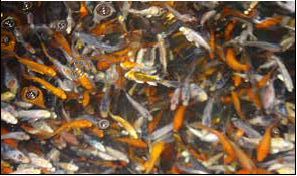7.4.2 Carp
Main commercial types:
Common carp (Cyprinus carpio)
Silver carp (Hypophthalmichthys molitrix) Grass carp (Ctenopharyngodon idella)

FIGURE 7.7
Line drawing and photograph of a grass carp (Ctenopharyngodon idella)
Description
Native to eastern Europe and Asia, carps are currently the most cultured fish species globally (Figure 7.7). Carp, like tilapia, are tolerant to relatively low DO levels and poor water quality, but they have a much larger tolerance range for water temperature. Carp can survive at temperatures as low as 4 °C and as high as 34 °C making them an ideal selection for aquaponics in both temperate and tropical regions. Best growth rates are obtained when temperatures are between 25 °C and 30 °C. In these conditions, they can grow from fingerling to harvest size (500-600 g) in less than a year (10 months). Growth rates dramatically decrease with temperatures below 12 °C. Male carp are smaller than females, yet can still grow up to 40 kg and 1-1.2 m in length in the wild.
In the wild, carps are bottom-feeding omnivores that eat a large range of foods. They have a preference for feeding on invertebrates such as water insects, insect larvae, worms, molluscs and zooplankton. Some herbivorous carp species also eat the stalks, leaves and seeds of aquatic and terrestrial plants, as well as decaying vegetation. Cultured carp can be easily trained to eat floating pellet feed.
Carp fingerlings are best obtained from hatcheries and dedicated breeding facilities. The procedure to obtain juveniles is more complicated than tilapia because spawning in female carps is induced by hormone injection, a technique requiring additional knowledge of fish physiology and experience.
Carps can easily be polycultured and this has been done for centuries. It mainly consists in culturing herbivorous fish (grass carp), planktivorous fish (silver carp) and omnivorous/detritivorous fish (common carp) together in order to cover all the food niches. In aquaponics, the combination of these three species, or at least grass carp with common carp, would result in a better use of food, as the former would feed on both pellet and crop residues while the latter would also seek for wastes accumulating at the bottom of the tank. The supply of roots, among other crop residues, would be also

FIGURE 7.8 Ornamental fish (Cyprinus carpio) in aquaponic system
extremely beneficial to the nutrient pool in the aquaponic system, because their digestion by the fish and the successive waste mineralization would return most of the micronutrients back to the plants.
Other carp species (ornamental fish)
Gold or Koi carps are mainly produced for the ornamental fish industry rather than food fish (Figure 7.8). These fish also have a high tolerance to a variety of water conditions and therefore are good candidates for an aquaponic system. They can be sold to individuals and aquarium stores for considerably more money than fish sold as food. Koi carps and other ornamental fish are a popular choice for vegetarian aquaponic growers.
Beyond the climatic characteristics and fish management issues, the choice of a carp species to be cultured in aquaponics should follow a cost-benefit analysis that takes into account the convenience in culturing a fish that is bonier and generally fetches lower market prices than other species.